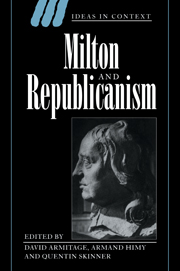Book contents
- Frontmatter
- Contents
- Notes on contributors
- Preface
- PART I DEFINING MILTON'S REPUBLICANISM
- 1 Milton's classical republicanism
- 2 Milton and the characteristics of a free commonwealth
- 3 Great senates and godly education: politics and cultural renewal in some pre- and post-revolutionary texts of Milton
- PART II MILTON AND REPUBLICAN LITERARY STRATEGY
- PART III MILTON AND THE REPUBLICAN EXPERIENCE
- PART IV MILTON AND THE REPUBLICAN TRADITION
- Index
- Recent titles in the series include
2 - Milton and the characteristics of a free commonwealth
Published online by Cambridge University Press: 27 October 2009
- Frontmatter
- Contents
- Notes on contributors
- Preface
- PART I DEFINING MILTON'S REPUBLICANISM
- 1 Milton's classical republicanism
- 2 Milton and the characteristics of a free commonwealth
- 3 Great senates and godly education: politics and cultural renewal in some pre- and post-revolutionary texts of Milton
- PART II MILTON AND REPUBLICAN LITERARY STRATEGY
- PART III MILTON AND THE REPUBLICAN EXPERIENCE
- PART IV MILTON AND THE REPUBLICAN TRADITION
- Index
- Recent titles in the series include
Summary
Milton's republicanism emerges after the event. Before the execution of the king, there is no evidence that he had added constitutional radicalism to the array of heterodox and oppositional opinions he had shown in his pamphlets of 1641–5. But the increasing radicalism of the positions he assumed within the debates of that period makes his later commitment to Revolutionary Independency unsurprising.
Certainly Milton's subscription to a militant and uncompromising version of antiprelatism, a root-and-branchism which excluded compromise with anti-Laudian episcopalians, had, as early as 1642, signalled an incipient alienation from the Presbyterian position. He had begun to part company with those among more moderate puritans who were prepared to entertain a new church settlement with an episcopacy purged of its Laudian innovations, as some of the Smectymnuans evidently sought. By the time he published The Reason of Church-Government early in 1642 a discerning reader could detect in his uncertainties about the right response to the sects the stirrings of the Independent tendency. In his tracts of 1643–5 he manifested a singularity of doctrine (on the issue of divorce) indicative of one who could not for long expect to find a place in even a newly reformed and Presbyterian Church of England. In a sense, one can often best place a political writer by the identity of his enemies. Milton's divorce tracts provoked the sustained and probably coordinated attack of Presbyterians and others of a militantly anti-Independent orientation. His response to these assaults was both to reiterate his thesis, in The Judgement of Martin Bucer (1644) and Tetrachordon (1645), and to develop in Areopagitica an argument for limited toleration of Protestant.
- Type
- Chapter
- Information
- Milton and Republicanism , pp. 25 - 42Publisher: Cambridge University PressPrint publication year: 1995
- 14
- Cited by



